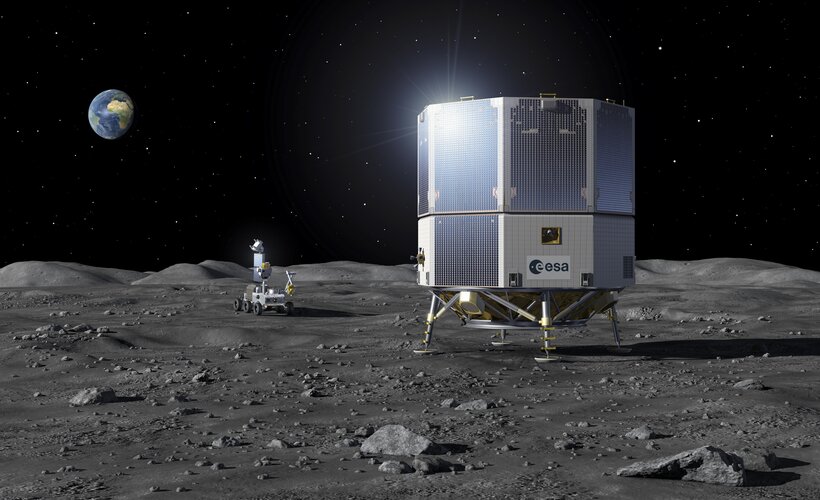BlackSky advances AI-powered space intelligence with critical design review success
Friday, 21 March 2025 08:38 BlackSky Technology Inc. (NYSE: BKSY) has reached a significant milestone by completing a critical design review (CDR) for a major international defense partner. This accomplishment confirms that BlackSky's upcoming next-generation architecture, anchored by its Gen-3 satellite constellation, will provide rapid, secure, AI-driven intelligence in near real time.
"Completing the CDR is a monu
BlackSky Technology Inc. (NYSE: BKSY) has reached a significant milestone by completing a critical design review (CDR) for a major international defense partner. This accomplishment confirms that BlackSky's upcoming next-generation architecture, anchored by its Gen-3 satellite constellation, will provide rapid, secure, AI-driven intelligence in near real time.
"Completing the CDR is a monu South Africa China achieve milestone with 12900 km quantum satellite connection
Friday, 21 March 2025 08:38 Scientists from South Africa and China have achieved a historic milestone in quantum communication by creating the world's longest ultra-secure quantum satellite link, spanning an unprecedented 12,900 km. This link, established using the Chinese quantum microsatellite Jinan-1 in low Earth orbit, is also the first of its kind ever implemented in the Southern Hemisphere.
The collaboration be
Scientists from South Africa and China have achieved a historic milestone in quantum communication by creating the world's longest ultra-secure quantum satellite link, spanning an unprecedented 12,900 km. This link, established using the Chinese quantum microsatellite Jinan-1 in low Earth orbit, is also the first of its kind ever implemented in the Southern Hemisphere.
The collaboration be Advancing satellite methods for mapping coastal seabeds
Friday, 21 March 2025 08:38 Researchers from Flinders University are pioneering cost-effective techniques for collecting essential coastal elevation data, known as bathymetry, by leveraging satellite technology to monitor environmental shifts along South Australia's coastline.
"High-precision traditional technologies such as topographic profiling, boat-based echo sounders and sonar are currently the best available me
Researchers from Flinders University are pioneering cost-effective techniques for collecting essential coastal elevation data, known as bathymetry, by leveraging satellite technology to monitor environmental shifts along South Australia's coastline.
"High-precision traditional technologies such as topographic profiling, boat-based echo sounders and sonar are currently the best available me Pixxel satellites deliver groundbreaking hyperspectral imaging milestone
Friday, 21 March 2025 08:38 Pixxel, a leader in hyperspectral imaging technology, has announced a major advancement in Earth observation as its trio of Firefly satellites has captured and transmitted their inaugural 'First Light' imagery. These images set a new benchmark, marking the highest-resolution hyperspectral images ever acquired from space.
Following a flawless commissioning process, all three satellites are
Pixxel, a leader in hyperspectral imaging technology, has announced a major advancement in Earth observation as its trio of Firefly satellites has captured and transmitted their inaugural 'First Light' imagery. These images set a new benchmark, marking the highest-resolution hyperspectral images ever acquired from space.
Following a flawless commissioning process, all three satellites are Spire debuts AI weather forecasting models built with NVIDIA Omniverse Earth2 tech
Friday, 21 March 2025 08:38 Spire Global, Inc. (NYSE: SPIR) has introduced two state-of-the-art artificial intelligence weather models, AI-WX and AI-S2S, which utilize the NVIDIA Omniverse Blueprint for Earth-2 platform. These advanced systems are powered by Spire's exclusive satellite-derived data and offer medium-range and sub-seasonal forecasts designed to support sectors like energy, utilities, and commodities with hig
Spire Global, Inc. (NYSE: SPIR) has introduced two state-of-the-art artificial intelligence weather models, AI-WX and AI-S2S, which utilize the NVIDIA Omniverse Blueprint for Earth-2 platform. These advanced systems are powered by Spire's exclusive satellite-derived data and offer medium-range and sub-seasonal forecasts designed to support sectors like energy, utilities, and commodities with hig Earth from Space: Land of giants
Friday, 21 March 2025 08:00 Image:
The Copernicus Sentinel-2 mission takes us over the Sequoia and Kings Canyon National Parks in California’s Sierra Nevada mountains.
Image:
The Copernicus Sentinel-2 mission takes us over the Sequoia and Kings Canyon National Parks in California’s Sierra Nevada mountains. French VLEO 5G startup strikes telecoms infrastructure partnership
Thursday, 20 March 2025 21:25
French satellite broadband startup CTO has teamed up with TDF, which operates France’s largest network of carrier-neutral hosting sites, to help integrate its proposed VLEO 5G services with terrestrial telcos.
U.S. Space Force budget trimmed in full-year continuing resolution
Thursday, 20 March 2025 20:23
The U.S. Space Force will operate with $28.7 billion in funding for fiscal year 2025, $800 million less than its requested budget of $29.5 billion
Hubble sees a spiral and a star in the constellation Virgo
Thursday, 20 March 2025 19:36This request seems a bit unusual, so we need to confirm that you're human. Please press and hold the button until it turns completely green. Thank you for your cooperation!
Press and hold the button
If you believe this is an error, please contact our support team.
185.132.36.159 : 47258fc8-b1c2-4720-b48f-3f855bd0
Making the rules for the final frontier
Thursday, 20 March 2025 15:21
In this week's episode of Space Minds, Richard DalBello, Principal, RDB Space sits down with host David Ariosto.
332nd ESA Council: Media information session
Thursday, 20 March 2025 13:00 Video:
00:34:08
Video:
00:34:08
Watch the media information session in which ESA Director General Josef Aschbacher and ESA Council Chair Renato Krpoun (CH) update journalists on the key decisions from the ESA Council meeting, held at ESA Headquarters in Paris on 19 and 20 March 2025.
Read ESA's Strategy 2040
Thursday, 20 March 2025 12:00
ESA's Strategy 2040
Read the Five Goals
ESA and JAXA strengthen ties on Moon and Mars exploration
Thursday, 20 March 2025 12:00
The European Space Agency's (ESA) Director of Human and Robotic Exploration, Daniel Neuenschwander, and the Japan Aerospace Exploration Agency's (JAXA) Vice President for Exploration and Human Spaceflight, Mayumi Matsuura, have signed a new statement of intent focused on Moon and Mars activities. This statement marks their intention towards a step forward in space exploration cooperation between ESA and JAXA, and lays the groundwork for expanded collaboration between the two agencies in advancing science, technology and international partnerships.
Spaceo leads ESA project to deploy inflatable sail for satellite disposal
Thursday, 20 March 2025 11:20 A European initiative spearheaded by Portuguese start-up Spaceo has secured a European Space Agency (ESA) contract to create a novel solution for clearing obsolete satellites and debris from orbit.
The program, called SWIFT (Spacecraft With Inflatable Termination), has received euro 3 million in funding to develop a deployable sail-like structure that acts as a drag device to hasten the d
A European initiative spearheaded by Portuguese start-up Spaceo has secured a European Space Agency (ESA) contract to create a novel solution for clearing obsolete satellites and debris from orbit.
The program, called SWIFT (Spacecraft With Inflatable Termination), has received euro 3 million in funding to develop a deployable sail-like structure that acts as a drag device to hasten the d How Altegrio is Redefining AI Development Services
Thursday, 20 March 2025 11:20 AI is one of the most popular and controversial topics discussed today, not only in tech-focused media. We decided to find out what running an AI development company is like today. To do this, we interviewed Oleg Goncharenko, a man who has been in charge of such a business for almost 15 years. Oleg himself is an entrepreneur with over 25 years of business experience, 15 of them in tech businesse
AI is one of the most popular and controversial topics discussed today, not only in tech-focused media. We decided to find out what running an AI development company is like today. To do this, we interviewed Oleg Goncharenko, a man who has been in charge of such a business for almost 15 years. Oleg himself is an entrepreneur with over 25 years of business experience, 15 of them in tech businesse 
